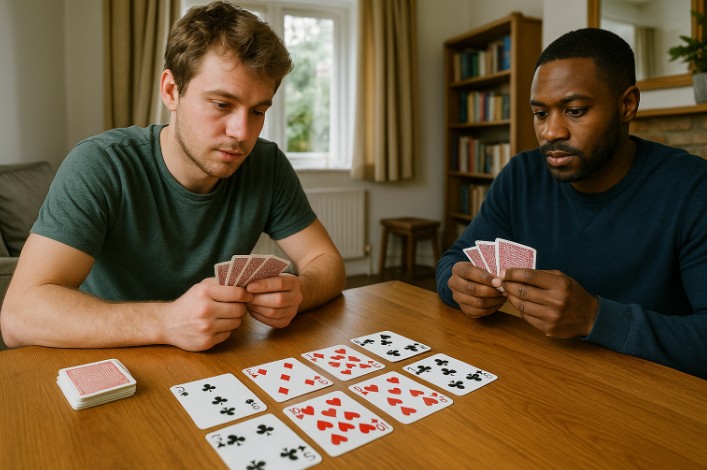The War card game, known for its simplicity and excitement, has remained a family favourite across generations. Commonly referred to as “Battle” in the United Kingdom, this game is ideal for players of all ages due to its straightforward rules and the minimal skill required to play.
While it relies heavily on chance, its unpredictable nature adds to the fun. In this article, we explore how to play War card game, from setup to strategy, as well as various rule variations and tips for improving your winning odds.
What Is the War Card Game and Why Is It So Popular?

War, often referred to as “Battle” in the UK, is one of the simplest card games in the world. It is primarily played by two players using a standard 52-card French deck. The object of the game is to win all the cards, and it involves no bidding, no discards, and no point-keeping.
The game’s popularity stems from its accessibility. It requires virtually no learning curve and can be enjoyed by children and adults alike. War is an excellent introductory game for young players learning card values, while still being a relaxing and competitive pastime for adults.
The game is highly chance-based, meaning that no prior experience or strategy is needed to begin. This level playing field contributes to its wide appeal across all age groups and skill levels. It also accommodates house rules and cultural variations easily, adding to its replay value.
How Do You Set Up the War Card Game?
Setting up the game is a straightforward process. Players need a single 52-card deck, although some variations include Jokers.
Each player is dealt half of the deck, resulting in two equal piles of 26 cards. These cards are placed face down in front of each player. Players are not allowed to look at their cards during the game, as this would disrupt the element of randomness and surprise that defines War.
In games with three or four players, the deck is divided equally among all participants. Any leftover cards can be removed or distributed as agreed. Each player forms a face-down draw pile from which they play.
Key setup points:
- Use a shuffled 52-card deck (Jokers optional)
- Deal 26 cards to each player in a 2-player game
- For 3 or 4 players, distribute cards as evenly as possible
- Players do not look at their cards until each round is played
How Do You Play the War Card Game Step by Step?
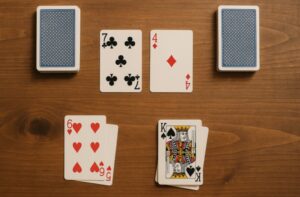
The gameplay in War is highly straightforward, making it an excellent choice for new players or young children. However, understanding each step in detail will ensure smoother gameplay and fewer misunderstandings during play. Here’s a comprehensive guide on how to play the War card game from beginning to end.
Step 1: Prepare the Deck and Deal Cards
Start with a standard 52-card deck. If you’re using Jokers (optional), make sure all players agree on how they will be ranked (usually the highest card). Shuffle the deck thoroughly to ensure randomness. For a two-player game, divide the deck evenly, giving each player 26 cards. The cards must be placed face-down in a single stack.
Step 2: Begin the First Round (Battle)
Each player simultaneously turns over the top card from their stack and places it face-up in the middle of the play area. These two cards are compared to determine which has the higher value. The suits are not considered—only the rank of the card matters.
For example, if Player A reveals a 9 and Player B reveals a Queen, Player B wins the round because the Queen outranks the 9. The winner collects both cards and places them face-down at the bottom of their stack.
Step 3: Continue the Game in Rounds
The game proceeds in the same manner. Players reveal their top cards at the same time, compare values, and the winner collects both cards. This continues until a tie occurs or one player runs out of cards.
Step 4: Handle a Tie (War)
If both players reveal cards of equal rank—such as two 8s—a war is triggered. Each player then places three cards face-down on top of their face-up card. After that, they each reveal a fourth card face-up. The new face-up cards are compared just like a normal round.
The player with the higher face-up card after the war wins all the cards that have been placed on the table, including both the original tie cards and all the face-down and face-up war cards.
If the new face-up cards are also of equal rank, the war continues. Players again place three cards face-down and one face-up. This can repeat as many times as necessary until one player reveals a higher card and wins all the accumulated cards in that war sequence.
Step 5: Repeat Until the Game Ends
The process of revealing, comparing, and collecting cards continues until one player has captured the entire deck. Alternatively, some players prefer to set a time limit or a fixed number of rounds, in which case the winner is the player with the most cards when the game ends.
Example Gameplay Flow:
| Player A (Top Card) | Player B (Top Card) | Result |
| 7 | 10 | Player B wins round |
| K | K | War is declared |
| Q (War Card) | 9 (War Card) | Player A wins war |
| 2 | 5 | Player B wins round |
This simple, repetitive structure is what gives War its charm and addictiveness. Despite being based largely on chance, the unpredictability of each round keeps players engaged.
What Are the Basic Rules of the War Card Game?
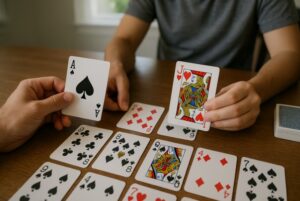
While War is known for its simplicity, having a firm grasp of its rules is essential to enjoy the game fully and to resolve disputes quickly during play. Below is an expanded explanation of the core rules that govern every game of War.
Card Ranks and Order of Value
The game is based entirely on comparing the ranks of cards. The suit (hearts, diamonds, clubs, spades) has no effect on the outcome. Aces are always the highest card unless a house rule says otherwise, followed by Kings, Queens, and so on down to 2s, which are the lowest.
Here is the complete ranking of cards from highest to lowest:
| Card Rank | Value |
| Ace | Highest card |
| King | High |
| Queen | High |
| Jack | High |
| 10–2 | Standard |
Playing Cards Face-Down and Face-Up
Players must always draw the top card from their deck without looking at it beforehand. During regular rounds, the drawn card is placed face-up so both players can compare the values.
In war scenarios, each player must place three cards face-down before drawing a fourth face-up card. These face-down cards act as “battleground stakes,” and cannot be reviewed, changed, or rearranged once placed. This rule maintains the fairness and randomness of each war round.
Winning and Collecting Cards
When a player wins a round or a war, they collect all cards involved in that round. These collected cards are added to the bottom of their draw pile, maintaining the order in which they were won. Players are not allowed to shuffle the won cards unless a variant of the game permits it.
Over time, winning rounds helps a player build a larger deck. The ultimate goal is to win all cards in the deck, although this can take a considerable amount of time depending on the pace of play and number of wars.
Running Out of Cards
A common issue in War is when a player runs out of cards during a war. There are several ways to handle this, and it should be agreed upon before the game begins. The most common approaches are:
- The player automatically loses the war (and potentially the game).
- The player uses their last available card as the war card.
- The player is allowed to continue if the last card wins the war.
These rules are not universal and can be tailored to suit the age group or experience level of the players.
Disputes and Clarifications
Because War is often played casually without a rulebook, disputes can arise about how many cards to lay during a war or whether jokers are allowed. These details should be clarified before starting the game.
General rule reminders:
- Suits do not matter; only card ranks do.
- Cards must be played from the top of the deck, not selected or arranged.
- The collected cards go to the bottom of the winner’s deck in the order they were won.
- Aces beat all other cards unless specified otherwise by a variant rule.
By sticking to these basic rules and establishing house rules for uncommon situations, players can enjoy a seamless and entertaining experience.
How Is a War Declared and Resolved in the Game?
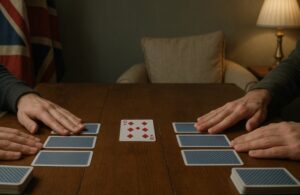
When both players flip over cards of equal rank, a war begins. Each player places three cards face down on top of the tied cards and then places one more card face up. The player with the higher new face-up card wins all the cards currently on the table.
If the new face-up cards are again tied, the war continues with the same procedure. This can happen repeatedly until a winner is determined.
Handling wars:
- Each player places three face-down cards and one face-up card
- The highest face-up card wins all the cards played
- If tied again, repeat the war process
- Captured cards are added to the bottom of the winner’s pile
A unique aspect of War is that it can become extended or infinite depending on how cards are shuffled and recycled. Some house rules limit the number of wars or rounds to prevent this.
What Are the Winning Conditions in War?
The game continues until one player holds all the cards, making them the winner. However, due to the game’s length and unpredictable nature, many players choose to impose a time or round limit. In such cases, the player with the most cards at the end of the session is declared the winner.
Players can agree on variations to determine the winner more efficiently:
| Winning Condition | Description |
| Total card capture | Player wins by collecting the full deck |
| Highest card count | After a set time, the player with most cards |
| Elimination format | In multiplayer games, last remaining player wins |
| Limited round play | Winner is decided after a fixed number of rounds |
Some variations penalise players for running out of cards during a war by declaring an automatic loss. Others allow them to use their final card as the deciding face-up card.
Are There Any Strategy Tips to Improve Your Chances of Winning?
While War is largely based on luck, certain approaches can subtly improve a player’s odds in longer games or specific variations.
Strategies include:
- Keeping cards in the same order they are won helps preserve randomness
- Memorising high-value cards can help anticipate upcoming plays, especially in smaller decks
- In variations where players decide card placement order, place higher cards early to increase chances in future rounds
- Avoid shuffling the discard pile unless explicitly allowed by the rules
Although these tips cannot guarantee victory, they may give attentive players a slight edge, particularly in games where rules permit strategic depth.
What Are the Popular Variations of the War Card Game?
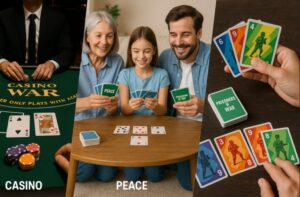
While the traditional version of War is widely known for its simplicity and luck-based gameplay, several variations have emerged over time to add depth, strategy, or excitement.
These adaptations not only help to shorten gameplay but also make the game more suitable for different age groups, skill levels, and playing environments. Below is a breakdown of some of the most popular and well-documented War card game variations.
Casino War
Casino War is a fast-paced version of War designed for gambling environments and is commonly found in land-based and online casinos.
Unlike the traditional game, which pits players against one another, Casino War is played against the dealer (also called the house). Both the player and the dealer draw a single card, and the higher card wins.
If a tie occurs, the player is given two options: surrender and lose half their bet, or “go to war” by matching their original stake. During the war, both draw another card, and if the player’s second card is higher or equal to the dealer’s, they win the full amount. This version introduces risk and decision-making, which are absent in standard War.
Prisoners of War
In this strategic multiplayer variation, when a player wins a battle, they are allowed to select one card from the defeated cards as a “prisoner.” This prisoner card is placed face-up in front of the player and can be used instead of drawing from the deck in a future round. If a player loses using a prisoner card, they forfeit both the prisoner and the card they would have drawn.
This variation adds a strategic element by allowing players to manage potential high-value cards and make tactical choices. It also adds complexity suitable for older players looking for more control over gameplay.
Bettelmann (Beggar Man) and Tod und Leben (Life and Death)
These are traditional German variations of War, played using a 32-card Skat deck instead of the standard 52-card deck. In Bettelmann, each player starts with 16 cards face-down.
Players turn over their top cards simultaneously, and the higher card wins. In the event of a tie, players turn over another card, and the winner takes all four cards in play.
In Tod und Leben, suits may have significance depending on the agreed rules. The game is usually themed and named symbolically—”Life” and “Death”—to reflect the stakes of each round.
These variants are generally shorter in duration due to the reduced number of cards and are excellent for cultural or educational use.
Automatic War
In this house rule-based version, anytime a player lays down a “2”, it automatically triggers a war, regardless of the other player’s card. This rule increases the frequency of wars and makes the game more dramatic, especially in a game where players are seeking more excitement or tension.
It’s particularly appealing for younger players who enjoy the suspense of war rounds, although it can extend the game’s duration if used frequently.
Peace
Peace is a tongue-in-cheek reversal of the traditional game rules. In this version, the lowest card wins the round instead of the highest. All other rules remain the same, including the process of going to war when ties occur. Peace changes the mindset of players and offers a refreshing twist to gameplay dynamics.
It may take a few rounds for players to adjust to this inversion of rules, but it often leads to surprising and humorous outcomes.
Underdog
Underdog adds a clever mechanic to the war process. If the losing player in a war has a Jack among their three face-down cards, they automatically win the war—even if their face-up card is lower. This hidden surprise element gives the losing player a last-minute chance to reclaim the round and can shift the momentum unexpectedly.
This variation introduces anticipation and slight strategic suspense. Players may find themselves rooting for the “underdog” in the hope of pulling a Jack when all seems lost.
Comparative Summary of Variations:
| Variation Name | Number of Players | Key Rule Change | Complexity | Ideal For |
| Casino War | 1 vs Dealer | Played against house; betting involved | Moderate | Adults, Casino Players |
| Prisoners of War | 3+ | Capture and reuse opponent’s cards strategically | High | Teenagers, Strategy Lovers |
| Bettelmann / Tod | 2 | 32-card deck; cultural variant | Moderate | Cultural/Educational Play |
| Automatic War | 2+ | Any 2 card triggers war automatically | Low | Children, Fast-Paced Games |
| Peace | 2 | Lowest card wins instead of highest | Low | Casual, Humorous Sessions |
| Underdog | 2+ | A Jack in war gives losing player automatic win | Moderate | Players seeking surprise wins |
These variations reflect how adaptable the War card game can be. Depending on the occasion or players involved, you can switch to a version that adds strategy, humour, or speed. The availability of such variants keeps the game fresh and replayable, making War a classic that continues to evolve.
How Is the War Card Game Adapted for Kids or Beginners?
War is frequently used as a teaching tool in classrooms and family settings due to its ease of understanding. It can help young children grasp basic numerical values and practice comparing quantities.
To simplify for beginners:
- Use only half a deck to shorten the game
- Include visual aids on cards for younger children
- Reduce the number of face-down cards during a war to one instead of three
- Allow visual sorting of won cards to reinforce learning
These adjustments ensure that the game remains engaging while also being educational. It can be a helpful introduction to more advanced card games later.
How Does War Compare to Other Classic Card Games?
War differs significantly from games like Poker, Bridge, or Rummy, where skill, memory, and strategic planning are central. Instead, War prioritises accessibility and instant gameplay.
Here’s a quick comparison with other simple games:
| Game | Skill Involved | Setup Time | Suitable Age | Key Feature |
| War | Low | Minimal | 4+ | Pure chance and speed |
| Snap | Medium | Minimal | 5+ | Reaction-based |
| Go Fish | Medium | Short | 6+ | Memory-based |
| Slapjack | Medium | Minimal | 6+ | Speed and observation |
War’s ease of play makes it a top choice for families and casual gamers looking for a no-pressure experience.
Conclusion
The War card game remains a beloved classic thanks to its simplicity, accessibility, and timeless appeal. Though primarily a game of chance, it introduces players to basic card dynamics and competitive fun. Whether played casually at home, in school, or during family gatherings, War offers a fast-paced and entertaining experience for people of all ages. With numerous variations available, there’s always a fresh way to enjoy this enduring card game.
FAQs About the War Card Game?
Can more than two people play War?
Yes, War can be played by three or four players. Each player receives an equal portion of the deck. If there’s a war between tied players, only they participate while others wait.
What happens if a player runs out of cards during a war?
Rules vary: in some versions, the player loses immediately; in others, they may use their last card as the war card.
Is there any skill involved in playing War?
Minimal. The game is based on luck, although slight advantages can be gained through memory and card placement in some variants.
How long does a typical War card game last?
Anywhere from 10 to 40 minutes. However, due to the game’s nature, it can theoretically go on indefinitely.
Is War suitable for young children?
Absolutely. It’s often used as a teaching tool for basic counting and understanding card ranks.
Can jokers be used in the War card game?
Yes, but they are optional. Jokers are typically treated as the highest cards if included.
Are there official tournament rules for War?
No. War is generally considered a casual, recreational game and is not governed by official competitive rules.

